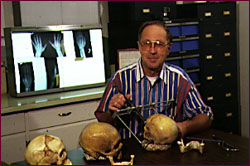
|

|
Richard L. Jantz Department of Anthropology, University of Tennessee, Knoxville Why should scientists be allowed to study the Kennewick skeleton? The study of human skeletal remains has been a component of biological anthropology since its origins 200 years ago. Human skeletons provide information about the past that is unobtainable from any other source, e.g., specific dietary components, activities, health, and genetic relationships. Kennewick Man in particular provides a window into a little-known time and place, and it is important in defining the early populations of the Americas. Of the 10 or so skeletons in the United States dating to 9000 before present or older, it is one of the best preserved. As such it constitutes over 10 percent of the evidence nationally. But in the Northwest-Plateau area, it constitutes well over 50 percent of the evidence. Skeletal remains help tell the story of human history; it is a history to which everyone is entitled. Access to human history should not be restricted by the government, nor should it be controlled by small groups of people. What would I personally hope to learn? My interest is in the patterns of skeletal variation temporally and geographically in prehistoric North America. Kennewick Man represents a time period from which there are few skeletons, so patterns are difficult to ascertain. Kennewick Man can contribute to two major questions in which I have an interest:
Relationships between early populations and recent Native Americans. Current evidence demonstrates that early populations differ markedly from recent ones. The reason for these differences has yet to be determined. Possibilities include: (a) substantial evolutionary change took place, or (b) early populations contributed little to the ancestry of recent Native Americans. Kennewick Man can make a substantial contribution to answering these questions. Does Race Exist? | Meet Kennewick Man Claims for the Remains | The Dating Game | Resources Transcript | Site Map | Mystery of the First Americans Home Editor's Picks | Previous Sites | Join Us/E-mail | TV/Web Schedule About NOVA | Teachers | Site Map | Shop | Jobs | Search | To print PBS Online | NOVA Online | WGBH © | Updated November 2000 |
 Richard Jantz
Richard Jantz
 Certain ancient skeletons, such as Spirit Cave Man
(reconstructed above) and Kennewick Man, appear to
represent different regional populations—a
finding that is forcing anthropologists to rewrite the
history of the first Americans.
Certain ancient skeletons, such as Spirit Cave Man
(reconstructed above) and Kennewick Man, appear to
represent different regional populations—a
finding that is forcing anthropologists to rewrite the
history of the first Americans.